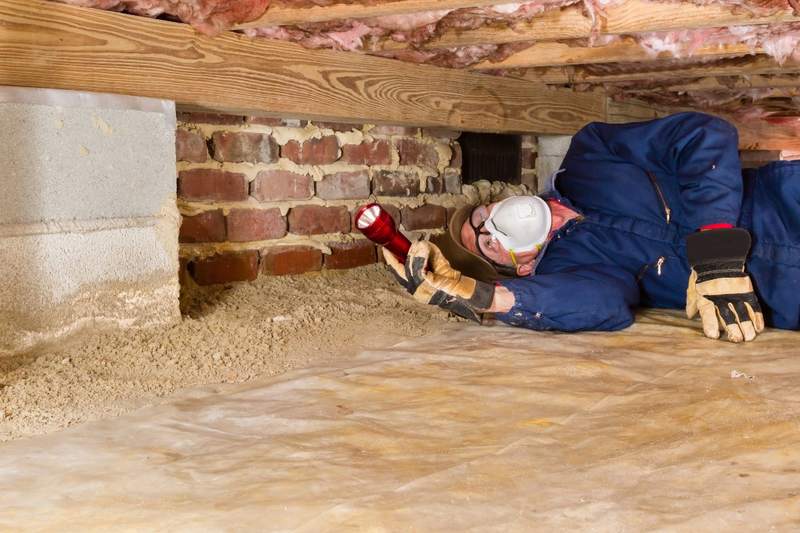When you’re touring homes, you might encounter a home with a crawl space. While this likely isn’t an area you’ll spend much time in, it’s still important to know what purpose a crawl space serves and how to maintain one.
Knowing what a crawl space is will give you valuable insight into how it affects your property’s structural integrity, ventilation, and overall home value. Here’s what you need to know about buying a home with a crawl space.
Key Takeaways:
- A crawl space isn’t a livable area of the home, but it can serve many functions, such as providing access to electrical and plumbing systems.
- Common problems in crawl spaces include moisture, pest infestations, and structural damage.
- There are several pros and cons to consider before buying a home with a crawl space.
Crawl Space Defined
A crawl space is an unfinished area beneath a house that offers access to systems like plumbing and wiring, and serves as a buffer between the living areas and the ground below.
A crawl space can extend under the entire length of the home or only a certain area. Because crawl spaces are out of sight and typically only 1 to 3 feet tall, homeowners tend to neglect this area of the home.
It’s not uncommon to tour a home with a crawl space, considering 15% to 20% of new homes are built on a crawl space. It’s good to know the differences between a crawl space and other types of foundations before buying a home.
What’s the difference between a crawl space and a concrete slab foundation?
A slab is a 6-to-8-inch concrete pad that offers a sturdy base for a home. Although crawl spaces and concrete slabs both are found beneath a home, a crawl space offers some protection if there’s a flood. A home with a slab foundation sits close to ground level, leaving the home more vulnerable.
Slabs are usually less expensive to build than crawl spaces, and work best in warmer climates where cracking from ice damage isn’t a major concern.
“With a crawl space, you can get underneath the house to work on things like plumbing and electricity,” says Mindy Jensen, a real estate agent at BiggerPockets, a community platform for real estate investors, in Longmont, Colorado. “If you need to make repairs or alterations to a home on a slab, you have to jackhammer the slab.”
What’s the difference between a crawl space and a basement?
Basements are partially or entirely underground spaces commonly used for living or storage, and are standard ceiling height. They are common in colder climates where the foundation is below the frost line, which is the depth where groundwater freezes. They also offer protection against severe storms and can sometimes work as a tornado shelter. Depending on the construction, a basement can offer utility system access, like a crawl space.
A finished basement adds value to a home and sometimes counts toward square footage, depending on whom you ask. However, building a house with a basement is usually much more expensive than building one with a crawl space. Basements require maintenance such as additional waterproofing, ventilation, or even a sump pump, which is a water pump for your basement.
What Are Crawl Spaces Used For?
Crawl spaces are common in the Pacific Northwest and serve several functions, including:
- Protect the home from flooding. A crawl space elevates the home from the ground, creating a buffer that mitigates flood damage.
- Minimize shifting in the home. Leveling and compacting dirt for a home’s foundation is costly, and there’s still a possibility that the home will shift. A crawl space eliminates the need to create a level foundation, and mitigates shifting or sliding. This is especially useful for homes built on a hill.
- Utility access. Homes with crawl spaces have easier access to electrical wiring; plumbing systems; heating, ventilating, and air conditioning units; and other utilities.
- Storage. Some crawl spaces can serve as storage for infrequently used or seasonal items, such as holiday decorations. Keep in mind that the crawl space should be moistureproof and sealed off from pests to be an effective storage space.
What are crawl spaces not used for?
A crawl space typically isn’t regularly accessed. Low ceilings, bad lighting, and susceptibility to moisture and pests are common reasons why homeowners avoid this area.
While they offer easier access to plumbing and wiring, crawl spaces aren’t a good place for water heaters or electrical panels.
Crawl spaces aren’t livable areas and don’t count toward square footage. Most crawl spaces also can’t be used for storage unless certain measures are taken, and they aren’t a good place to store food or other items that can be damaged from moisture or pests.
Elements of a Crawl Space
Different crawl spaces may contain different elements, but here are some common features you can expect to find in one:
- Floor joists are wooden or steel structural beams that support the weight of the home. They are placed parallel and equidistant from each other along the ceiling of the crawl space, often between load-bearing walls.
- Footings are load-bearing elements beneath ground level designed to support and distribute the weight of the structure.
- Beams and girders are horizontal supports transferring weight to the footings and walls.
- Piers are vertical supports installed in the ground, often supporting beams, girders, and joists.
- Vents are openings that allow air circulation in the crawl space to help regulate temperature, moisture, and air quality.
- Insulation provides a barrier for temperature, humidity, fire, and sound between the flooring and crawl space.
- Plumbing brings in clean water and disposes of sewage. While water heaters shouldn’t be in a crawl space, some piping from a water heater could run through this area.
- Electrical wiring can pass through the crawl space, offering easier access for electricians.
- Ducting connects rooms to a central HVAC system. While you wouldn’t want to heat or cool a crawl space, ducts commonly run through them.
- Vapor barriers are made from a material that prevents water from passing through, protecting the crawl space from ground-based moisture, which can cause mold, rot, and other problems.
Depending on the type of home, a crawl space may be accessible through a small doorway, an opening in the floor, or an entry outside the home. If the property has a basement and a crawl space, there could be an entry directly from the basement.
Common Problems in Crawl Spaces
A crawl space can be a helpful home feature, but it has potential drawbacks. Be aware of these risks when considering buying a home with a crawl space:
- Moisture from the soil can cause many problems, including mold, rot, and poor air quality in the home. Humid spaces also can attract termites and other pests.
- Mold or mildew are side effects of moisture that can be smelly at best and hazardous to your health at worst. If you don’t have the habit of checking your crawl space, your home could have mold without your knowledge.
- Termites are small bugs that eat away at the wood in your home. Undetected termites can lead to serious and expensive damage.
- Rodents or pests — such as mice, rats, and gophers — can find their way into a crawl space. Long-term rodent infestation can lead to property damage and health risks, such as salmonella.
- Plumbing leaks in a crawl space may go undetected for a period, leading to flooding or other damage before the pipes are repaired.
- Structural damage can come in the form of sagging or uneven floors. This could be a result of poor soil compaction or moisture that’s jeopardizing the wooden supports.
- Insulation can be fiberglass batts, foam board, spray foam, or vapor barriers doubling as insulation. Insulation may degrade over time, particularly if it’s exposed to moisture.
How to solve problems with a crawl space
Problems in a crawl space will likely require the help of a professional plumber, electrician, HVAC technician, mold remediation company, or other professional. The most expensive problems are radon mitigation, insulation, and flooding, according to Jensen.
“Radon is much more likely to collect in a crawl space — mitigation is key,” Jensen says. “Insulating the crawl space ceiling to help prevent cold air intrusion in the winter can help keep heating costs down. And if you have a slab foundation, there isn’t anything to flood, unlike a crawl space where water can collect.”
Costs vary widely, so inspecting your crawl space regularly is important to ensure you don’t miss problems before they become larger issues.
How To Maintain a Crawl Space
Having a well-maintained crawl space is critical to keeping your home in good condition. A clean space makes it easier to spot any problems and prevent them before they can start.
Regular maintenance should include inspections, checking vapor barriers and insulation, clearing ventilation, reviewing the home’s structural integrity, and pest control. You also can use a hygrometer to track moisture levels.
Common upgrades for crawl spaces
Upgrading your crawl space can help keep it in good condition and maximize its effectiveness. Popular home improvements for crawl spaces include:
- Enhancing vapor barriers, which controls moisture levels and reduces the risk of water-based structural damage.
- Enhancing insulation, which helps prevent heat loss in the home.
- Encapsulation, which completely seals the crawl space with a heavy-duty moisture barrier that manages humidity, prevents mold growth, and improves air quality in the home.
- Improving ventilation with vents or fans.
- Installing lighting to help with inspecting and navigating the crawl space.
- Increasing pest control measures, which can provide long-term benefits in terms of the condition of the home.
If you want to upgrade a crawl space down the line, consulting a professional before making substantial changes is crucial to ensure the most effective solutions for your home.
Pros and Cons of Buying a Home With a Crawl Space
Many homes have crawl spaces due to the practical benefits they offer. However, many crawl spaces can invite the same problems they were designed to prevent.
Here are the pros and cons of having a home with a crawl space.
Benefits of a crawl space
These are some benefits of buying a home with a crawl space:
- Unrestricted access to systems. Crawl spaces provide easier access to plumbing, electrical, and HVAC systems, making maintenance and repairs easier.
- Easier pest inspections. While a crawl space that isn’t properly sealed off may attract pests, it makes pest inspections easier to conduct.
- Warmer floors. When a crawl space is properly insulated and vented, the floors of the home tend to be warmer compared to a home with a slab foundation.
- Flood and earthquake buffer. Crawl spaces raise the home off the ground, providing an extra layer of protection from damage during floods and earthquakes.
- Good for homes with sloped lots. Slab foundations require extensive excavation to create a flat surface, which may not be practical for homes on sloped lots.
- Potentially adds more storage space. If properly sealed and weatherproofed, a crawl space can serve as additional storage space for certain seasonal items.
- Cost-efficient. Compared to basements, crawl spaces are less expensive to construct, and those savings can be passed down to you as the homebuyer.
Drawbacks of a crawl space
Here’s a list of some problems that can occur in a crawl space:
- Moisture. If not properly ventilated and sealed, crawl spaces can retain moisture, leading to structural damage over time.
- Susceptibility to mold or mildew. Excessive moisture in crawl spaces creates a conducive environment for mold and mildew, which can cause health problems — such as triggering asthma symptoms — and structural damage to the home.
- Pest infestations. Crawl spaces can become a haven for pests if they’re not properly sealed, leading to potential damage and infestations in the home.
- Limited potential. While crawl spaces can provide extra storage space, they often are damp and dusty with low ceilings, making them unsuitable for storing certain items.
Should You Buy a House With a Crawl Space?
If you buy a home with a crawl space, regular maintenance helps avoid problems — and large expenses — down the line.
According to Jensen, if you buy a home with a crawl space, it’s important to ensure it has a radon mitigation system and proper grading to allow for water drainage, and that it’s sealed off to prevent pests.
If the crawl space is well maintained, insulated, and ventilated, it can offer additional storage space and easier access to your home’s key systems. Also, if you live in a flood-prone area, a house with a crawl space can provide some protection from damage.
At the same time, a poorly maintained crawl space can lead to various issues, such as mold, mildew, pests, and structural damage. If you’re considering a house with a crawl space, it’s critical to inspect it regularly. Buying a home is a significant investment, and understanding the condition of the crawl space can help you protect that investment.
“Consider the crawl space an extension of the home,” Jensen says.
Crawl Space FAQ
Here are answers to frequently asked questions about crawl spaces.
Crawl spaces can be beneficial for homes on sloped sites because they help level the house structure and provide adequate drainage. In those situations, a home with a crawl space may be more practical than a home with a slab foundation.
The presence of a crawl space itself may not necessarily increase the value of a home. Still, a well-maintained, properly insulated, and ventilated crawl space could potentially make a home more attractive to buyers.
A concrete floor in a crawl space is generally considered better than a gravel or stone layer because it reduces moisture, discourages pests, and requires less maintenance. However, proper ventilation and moisture control remain essential.
The Bottom Line on Crawl Spaces
Crawl spaces might go unnoticed for the most part, but as you tour homes, it’s worth paying attention to them. A crawl space can play an important role in maintaining the condition of your property. Understanding its purpose can inform your decision on buying a home with a crawl space and help ensure you’re making the right investment.






